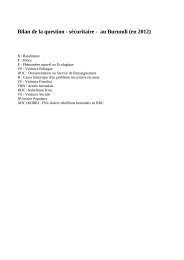Q3 Q4
g8iBkai
g8iBkai
You also want an ePaper? Increase the reach of your titles
YUMPU automatically turns print PDFs into web optimized ePapers that Google loves.
fran · q2 2016<br />
External borders refer to the borders between<br />
Member States and third countries.<br />
The borders between Schengen Associated<br />
Countries (Liechtenstein, Norway, Iceland<br />
and Switzerland) and third countries are<br />
considered as external borders as well. In<br />
turn, the borders between Schengen Associated<br />
Countries and Schengen Member<br />
States are considered as internal borders.<br />
For the indicators on detections of facilitators,<br />
illegal stay and asylum, statistics<br />
are also reported for detections at the<br />
land borders between Schengen Member<br />
States and Schengen candidates (Bulgaria,<br />
Croatia, Cyprus and Romania) or<br />
non-Schengen Member States (the UK and<br />
Ireland), so that a total for Member States<br />
and Schengen Associated Countries as a<br />
whole can be presented. It was not possible<br />
to make this distinction for air and<br />
sea borders since Member States do not<br />
habitually differentiate between extra-<br />
EU and intra-EU air and sea connections<br />
but tend to aggregate data for all arrivals.<br />
When data are examined at the level of<br />
third-country nationalities, a large percentage<br />
usually falls under the category<br />
of either ‘Other (not specified)’ or ‘Unknown’.<br />
It is expected that the percentage<br />
reported under these categories will<br />
decrease with time as Member States improve<br />
the quality and speed of their identification,<br />
data collection and reporting<br />
practices. It should be noted that if an individual’s<br />
nationality cannot be established<br />
before reports are submitted, it will be reported<br />
as ‘Unknown’.<br />
Acknowledgements<br />
The Frontex Risk Analysis Unit would like<br />
to express its gratitude to all FRAN and<br />
EDF-RAN members and their associates<br />
in Member State statistical, migration and<br />
document-fraud units who collect, aggregate<br />
and exchange monthly data, but<br />
also to the analysts who compile the bimonthly<br />
analytical reports, on which much<br />
of the detailed analyses presented here<br />
are based.<br />
5 of 37






